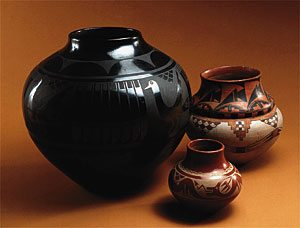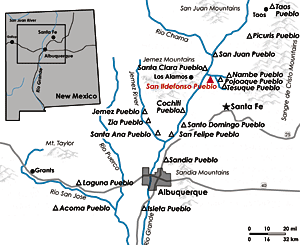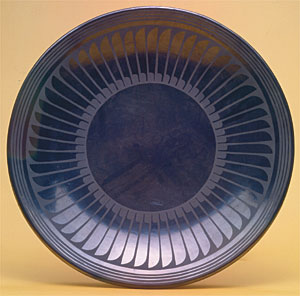The Art, Life, and Legacy of Maria Martinez
In the American Southwest, only arbitrary criteria separate “antiquities” from the thriving traditions of contemporary Indian art. Unlike in other areas of the world where sociopolitical and technological changes have caused a disconnection between the art of ancestral generations and that which is being created today, southwestern artistic traditions that emerged a thousand years ago continue to evolve. Yet due to a number of factors, including the introduction of manufactured goods and the development of tourism, Pueblo pottery is an art form that was very nearly lost a hundred years ago. Today, thanks in part to the foresight of a small group of scientists and art collectors and a few outstanding potters, Pueblo-Indian pottery is a thriving tradition that supports artists and families throughout the Native communities of New Mexico and Arizona.
The story of the acceptance of Pueblo pottery as “art” is inextricably tied to potter Maria Martinez (ca. 1887–1980). Martinez, and the various family members with whom she worked, produced pots that are highly acclaimed in the academic and collecting environments, with some examples bringing upwards of $500,000. Collectors appreciate not only the beauty of the work but also its place in the continuum of an ancient tradition. Through an examination of the historical context in which Maria Martinez developed as an artist, a greater understanding is gained of the myriad forces that have shaped Pueblo pottery making and continue to help establish innovations within the tradition.
Maria Montoya (Martinez) was born circa 1887 into the Tewa-speaking pueblo of San Ildefonso in northern New Mexico (Fig.1). As a young girl, she learned the art of pottery making in typical Pueblo-Indian style—by watching and doing—from two of the greatest potters of the time, her aunt, Nicolasa Peña, and Martina Montoya. These women taught her the skills required of a potter, but she learned the social dimensions of Pueblo art from her community.
Traditional Pueblo pottery making has always been a community endeavor and was often a major part of social interaction between family members. As a result, most artists specialized in certain steps in the process, such as pottery building, polishing, painting, or firing. The end result was a pueblo product and not an individual one. During her career, Maria nearly always collaborated with others. Before she married, she worked with her sisters, then with her husband, Julian. When he died in 1943, she worked with her daughter-in-law Santana Roybal, and ultimately with her son Popovi Da.
Pueblo Indians have been in the American Southwest for millennia and have a pottery-making tradition that dates back at least thirteen hundred years. Throughout most of this time, two different types of pottery were made—a utilitarian grayware and a paintedware. Grayware vessels were used for cooking and food storage, while painted vessels were used as serving bowls, for water storage, and for ceremonies. Although functionally different, both types were made using the same building techniques. Long, snakelike coils of clay were made and stacked until the desired vessel height was reached (Fig. 2). The vessel was then smoothed and thinned by scraping the moist clay into the desired shape. After the clay was thoroughly dry, the vessel would be fired in an open pit with wood used as fuel (cow dung is often used today). These pottery-building techniques have changed little throughout the centuries, except when raw materials were not as readily available.
By the mid-fourteenth century as the Pueblo people moved eastward from the original homelands in western New Mexico to their current locations along the Rio Grande, the white clays close to their prehistoric villages at Chaco Canyon and Mesa Verde were unavailable and red clays were substituted. The difference in clay color resulted in a black-on-red pottery instead of the familiar black-on-white. While continuity was important for Pueblo self-identity, it was not so inflexible as to stifle change.
Black-on-red pottery was the most common type produced at San Ildefonso when Maria was learning the craft, although its use was waning. The railroad arrived in Santa Fe in 1880, making manufactured goods widely available and inaugurating New Mexico as a destination for tourists. Prior to that time, Hispanic and Pueblo people of the middle and northern Rio Grande Valley depended upon Pueblo ceramics for most of their household cooking and storage needs. By the late 1800s, pottery was being replaced in Pueblo communities by manufactured metal and ceramic wares. The majority of pottery being produced at the pueblos was intended for sale to the burgeoning curio market, which favored exotic items and small pieces that were easy to transport.
These changes produced a discontinuity of pottery-making techniques that did not go unnoticed. A segment of Santa Fe’s cultural leaders took it upon themselves to help preserve what they believed was a dying art. They did this in two major ways. In 1922 they established a fund for the city’s Museum of New Mexico to purchase fine pieces of Pueblo pottery. With this fund, the museum’s founder, Edgar Lee Hewett, and others purchased pottery they considered to be of exceptional quality. They were willing to pay a significant premium over the regular price if the work met their standards, thus encouraging potters to make fewer, but better pieces. In the same year they also started the Indian Fair, now famous as Santa Fe’s “Indian Market,” in which prizes were awarded for the best Indian art. The prizes provided further incentive for potters to create well-made works of art.
Soon after the establishment of the Indian Fair, Maria Martinez, who was already well known to the museum’s staff, gained recognition beyond Santa Fe as an innovative artist. She began experimenting with pottery in the early 1910s, when most San Ildefonso Pueblo potters were still making the traditional black-on-red ceramic wares. Maria had made similar vessels, but she and her husband Julian had developed new techniques of creating pottery with two blacks, which impacted pottery making throughout northern New Mexico’s pueblos. By smothering the firing pit at the end of the firing process, the flow of air was stifled, thereby resulting in a chemical process that turned the pottery black rather than the traditional bright red. Where in the traditional manner the vessels were polished to a red finish after firing and decorated with a matte-black design, Maria’s black vessels were polished and then decorated with a matte-black paint, resulting in the black-on-black pots for which she is most well known (Fig. 3). Although still working within the realm of traditional Pueblo pottery making, she pushed the level of the aesthetic to a new height, one that helped launch her long career.
Maria’s pottery included traditional San Ildefonso Pueblo designs but also recognizable motifs from other Puebloan cultures, such as the prehistoric Mimbres feather designs seen in Figure 3. Changing fire temperatures, the applications of different colored paints and slips, refiring pots, and signing her work—unusual in the communal culture of her people—were just some of the innovations that kept Maria’s work fresh and the collectors returning for more (Fig. 4).
The legacy of Maria Martinez extends far beyond the world of art. By helping to create a demand for well-made pottery, she enabled others in her community to make a living. At the time of her birth, just thirty families lived within the pueblo of San Ildefonso. Today, artists and galleries thrive there and at other nearby Pueblo communities where many of Maria and Julian’s techniques and designs have been adopted. As a result of her technical mastery, creativity, and innovations, Pueblo pottery continues to develop as a living tradition within American Indian art.

-
Fig. 4: Cream-on-red ceramic jar by Maria Martinez and Popovi Da, ca. 1925 (cat. 53227/12). H. 7-1/2" (19 cm), D. 8-2/5" (21 cm); Black-on-black ceramic jar by Maria and Julian Martinez, ca. 1930 (cat. 18888/12). H. 18-1/2" (47 cm), D. 20-1/2" (52 cm); Polychrome ceramic jar by Maria and Julian Martinez, ca. 1919 (cat. 18798/12). H. 11" (28 cm), D. 8-2/5" (21 cm). Courtesy of Museum of Indian Arts and Culture, Santa Fe, New Mexico; photography by Blair Clark.
Many of the themes outlined here are presented in the exhibit Touched by Fire: The Art, Life and Legacy of Maria Martinez at the Museum of Indian Arts and Culture, Santa Fe, running through January 12, 2003. The exhibit features classic examples of Maria’s pottery in conjunction with archival photographs, supplemented with video interview commentary by contemporary potters and Maria scholars. Associated programs include lectures and artist demonstrations. Generous supporters of this exhibit at the time of printing include Medicine Man Gallery, Barbara Gonzales, Janis and Dennis Lyon, Jane and Bill Buchsbaum, and Doris and Arnold Roland.
-----
Douglas Patinka is an educator for the Museum of Indian Arts and Culture in Santa Fe, New Mexico. John A. Torres is the Curator of Archaeology for the Museum of Indian Arts and Culture in Santa Fe, New Mexico. He worked for the Navajo Nation as a tribal archaeologist for seven years, and collaborated on the exhibit Touched by Fire: The Art, Life and Legacy of Maria Martinez.
Suggested Reading:
Peterson, Susan. The Living Traditions of Maria Martinez. Harper and Row Publishers, 1977.
Spivey, Richard L. Maria. Northland Press, 1979.
Dillingham, Rick. Fourteen Families in Pueblo Pottery. University of New Mexico Press, 1994.


































